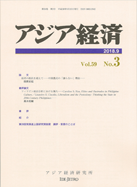Volume 63, Issue 1
Displaying 1-11 of 11 articles from this issue
- |<
- <
- 1
- >
- >|
Article
-
2022 Volume 63 Issue 1 Pages 2-20
Published: March 15, 2022
Released on J-STAGE: March 28, 2022
Download PDF (748K) Full view HTML
Note
-
2022 Volume 63 Issue 1 Pages 21-44
Published: March 15, 2022
Released on J-STAGE: March 28, 2022
Download PDF (704K) Full view HTML
Review Article
-
2022 Volume 63 Issue 1 Pages 45-71
Published: March 15, 2022
Released on J-STAGE: March 28, 2022
Download PDF (988K) Full view HTML
Book Reviews
-
2022 Volume 63 Issue 1 Pages 72-76
Published: March 15, 2022
Released on J-STAGE: March 28, 2022
Download PDF (309K) Full view HTML -
2022 Volume 63 Issue 1 Pages 77-80
Published: March 15, 2022
Released on J-STAGE: March 28, 2022
Download PDF (305K) Full view HTML -
2022 Volume 63 Issue 1 Pages 81-84
Published: March 15, 2022
Released on J-STAGE: March 28, 2022
Download PDF (320K) Full view HTML -
2022 Volume 63 Issue 1 Pages 85-87
Published: March 15, 2022
Released on J-STAGE: March 28, 2022
Download PDF (282K) Full view HTML -
2022 Volume 63 Issue 1 Pages 88-91
Published: March 15, 2022
Released on J-STAGE: March 28, 2022
Download PDF (345K) Full view HTML -
2022 Volume 63 Issue 1 Pages 92-94
Published: March 15, 2022
Released on J-STAGE: March 28, 2022
Download PDF (309K) Full view HTML
Bookcase
-
2022 Volume 63 Issue 1 Pages 95
Published: March 15, 2022
Released on J-STAGE: March 28, 2022
Download PDF (187K) Full view HTML -
2022 Volume 63 Issue 1 Pages 96-97
Published: March 15, 2022
Released on J-STAGE: March 28, 2022
Download PDF (182K) Full view HTML
- |<
- <
- 1
- >
- >|
